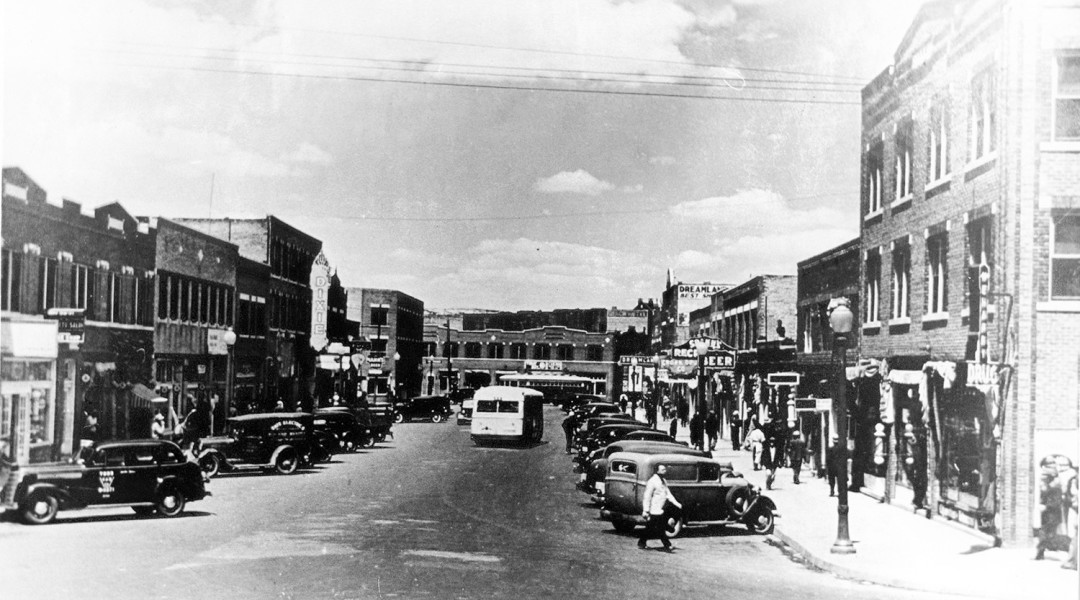
By Dawn Tree
Eagle Guest Writer
The district of Greenwood was once a thriving, booming area for black Tulsan’s. In the early 1900s, Greenwood was a legally segregated district, which allowed for concentrated economics; economics that funneled in and back out to the black community.
“Many black people, of every art form came to Tulsa to groom themselves,” a black business owner in the historic Greenwood district said, who wishes to remain anonymous.
The area was known as “America’s Black Wall Street,” that was until 1921, when the largest massacre in history took place; all spawned by the rumor that a black shoe shiner named Dick “Diamond” Roland attacked a young white elevator operator named Sarah Page. Ironically later rumored to have gotten married and seen in Chicago together.
Clyde Snow believed that the 1921 riot was not really much of a “riot” at all, but rather an act of ethnic cleansing facilitated by the Oklahoma National Guard, who was reported to have bombed Greenwood.
Snow is a forensic anthropologist who investigated claims from the Tulsa Race Massacre, in 1997, often referred to as a riot. Snow saw a strong parallel between the Tulsa massacre and the episodes of state-sponsored violence he had investigated abroad. He was a firm believer that the number of deaths reported was not the actual number, in fact he believed there were a number of mass graves dug. There were also reports of finding bodies in Arkansas washed up from the Arkansas river.
What’s The Point? Fighting To Keep Greenwood, Black Wall Street In The History Books.
Now many residents and those nationally and internationally don’t recognize the significance of this historic area. Presently, the black owned businesses in Greenwood can now be counted on two hands, less than 10.
“Even after the 1921 Massacre there were over 240 businesses that were then wiped out again by Urban Renewal,” Greenwood business owner anonymously stated.
Almost a century later “America’s Black Wall Street” hasn’t made it onto the Historical Registry list as a historical place.
“This is a historical place and this place needs to have people that can tell the story and appreciate what the people before them were able to accomplish,” said an anonymous business owner.
“Tulsa is still very, very racist and they need this preserved to have an entrepreneurial spirit, the spirit of Greenwood!”
Michael Reed, who is a strong political advocate for Tulsa and retired firefighter worked to bring 176 sidewalk markers out of a goal of 300, which was a part of the 2025 vision and grant money from the city of Tulsa. This also included 21 markers over the Martin Luther King, Jr. bridge downtown. The sidewalk markers highlighted people and businesses that existed in Greenwood.
“I went to the Oklahoma Historical Society’s archive, I spent three days accumulating a list of black businesses destroyed during the 1921 Race Massacre, which were found in the archives of older collections of Tulsa’s City Directory at Tulsa Central Library,” Reed states.
“The businesses were easily found due to the small ‘c’ in parentheses, denoting in code, that it was a black business or ‘c’ for colored during the racial unrest and segregated period of racial hatred and violence.”
Those facts alone reveal that if history isn’t honored and captured by those that care, it will go unknown.
Has Anyone Tried To Make It A Historical Marker?
“Yes. We started working on the application and request to become a historical place on the registry over a decade ago,” Reed states. “There were a few outside of us though.”
The National Register of Historic Places, established under the National Historic Preservation Act of 1966, is the catalogue of the archeological and historic properties that are significant in our nation’s heritage, according to the Oklahoma historical societies website factsheet.
A group of community members would meet in a business in Greenwood, including Doris Williams, Mary Williams, Julius Pegues, Ed Goodwin and more. At the end of the day it was between two names—that was supposedly the dividing line that has kept the historic district from becoming a historical place on the historical marker.
The two nominated names were the Renaissance of Black Wall Street Historical Greenwood District and Race Riot (Massacre) District. One would think this was a no brainer.
Terri Myers was a consultant on the project with the State Historic Preservation Officers (SHPO). According to Reed she was a cool and understanding person and apparently had seen nothing like this before.
The state questioned the integrity and criteria, talked to stakeholders, whom many were in agreement with, even white business owners including Fat Guys, friends of Greenwood and tenants, stated anonymously.
The criteria listed on the National Register Criteria factsheet states—properties eligible for listing are those (a) that are associated with events that have made significant contributions to the broad patterns of our history; (b) that are associated with the lives of persons significant in our past; (c) that embody the distinctive characteristics of a type, period, or method of construction, or that represent a significant and distinguishable entity whose components may lack individual distinction; or (d) that have yielded or may be likely to yield information important in prehistory or history.
“There was definitely discrimination involved—underhandedly done, overtly underhanded, “anonymous business owner says.
The Outcome? Why The Hold U
The name was never decided but Myers was awarded. “SHPO accepted her work then reconstructed and devised their version, submitted and I guess under her work contract had to pay her for work done, which was $20,000—then she went back to Texas,” Reed said.
It was stated by both anonymous business owners and Reed that there were/are over 20 different groups doing things separately instead of just coming together.
“It’s sad we can’t even support each other, we’re calling each other out on the news media and on Facebook,” said Tori Tyson of Blow Out Studio, a third-generation black owned business in Greenwood.
It was stated anonymously that the majority don’t have the real vision.
“In 2010 our efforts were denied by a trial judge and jury,” Mary Williams, campaign advisor for the efforts stated.
What are the benefits?
Listing in the National Register provides (1) recognition of a property’s significant; (2) limited protection; (3) owner eligibility for federal tax incentives under certain circumstances; and (4) eligibility for matching grants when such funds are available.
What happens now?
The obvious answer would be to appeal. Anyone can appeal the decision. “Now we’re kind of waiting on the Greenwood Chamber of Commerce to make a move,” Reed says.
Apart from the historical registry efforts, Reed had proposed a plan for the Evans/Fintube site of 50 acres that has been vacant for years just east of the railroad tracks. His plan included strong efforts to create economic development of Tulsa north and allow for amenities to create a tourism district connecting Lansing, Independence, Archer, Greenwood to the John Hope Franklin historical districts. This would include hotel, restaurant, performing venue, an entrepreneurship center and more.
That area is now planned to be the headquarters of a BMX trials track as announced by Mayor G.T. Bynum in July.
“The BMX park seems to be a desecration and implies disrespect,” Reed says. “It does not pay tribute, honor nor respect for the destruction caused and hundreds of deaths.”
Also stating that it’s like erecting amusement type venues to the east and west avenues of Greenwood district, something that was probably never contemplated in proximity to what occurred in the death camps in Germany (holocaust).
“It’s simply sad and in poor taste,” Reed said. We lost young entrepreneurs when we suffered the massacre on Greenwood, the builders and parents of those businesses that had children and could have passed their trades and skills and business savvy to their children were destroyed/killed.
The children are those that suffered all of the damage and didn’t have the opportunity to be young entrepreneurs themselves, which is a loss we are still suffering from today,” anonymous Greenwood business owner stated.
Obvious Problems?
Problems consist of not having enough foot traffic or amenities to keep people meandering. Allowing business owners into the district that are not passionate about this area. Not supporting businesses that have been consistently in Greenwood district for decades by raising their rent and giving shorter contracts than some wealthier counterparts, that are primarily not black.
Solutions?
- There is a Greenwood art gallery/archive center set to open this coming first Friday of September.
- Reed suggested a tax abatement for 5-10 years that would reduce or eliminate the amount of property tax owners would pay.
- Lower the cost of rent period
- There has already been murals created and efforts to bring more historical murals to the area
- Unity and transparency
“It’s embarrassing that the National African American Museum in Washington, D.C. has us honored in their museum and the city of Tulsa and many community members haven’t been able to work together to preserve our true legacy,” Reed says.
Written by Dawn Tree, writer and CEO of Underground Tree Projects a marketing company. She can be reached at www.utreep.com










